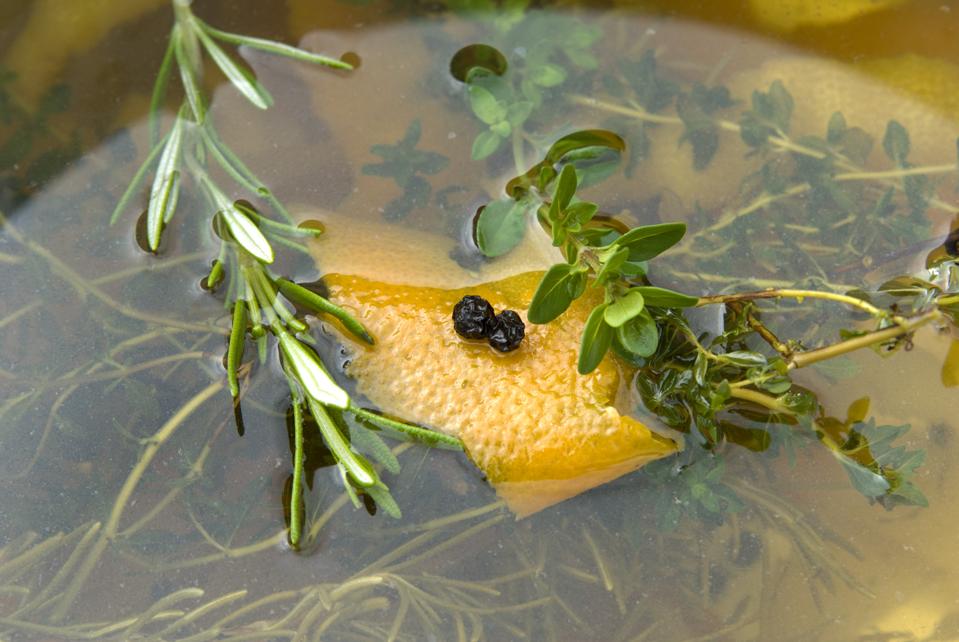Every Thanksgiving, the turkey takes center stage. And every year, home cooks overthink, rush, or dry it out. But the professionals who know their way around the bird agree that success has less to do with fancy gadgets and more to do with patience, preparation, and paying attention to detail. Get Thanksgiving turkey tips on brining, seasoning, frying, and serving a bird that is truly centerpiece-worthy from the experts.
Thaw Slowly—The First Key to Success
Before you think about seasoning, roasting, or frying, start with a proper thaw. “Where you get into trouble,” says Heidi Diestel, fourth-generation turkey farmer at Diestel Family Ranch, “is when you try to thaw the turkey really fast. The bird thaws too rapidly—slow is the way to go.”
A steady thaw in the refrigerator, roughly 24 hours per five pounds, is essential for even cooking. Shortcuts like hot water baths or countertop thawing can create food safety risks and uneven texture. Patience, Diestel says, is the first step to a juicy, golden-brown bird.
Choose a Flavor Direction Early
“Turkey has a way of taking on any flavor profile,” Diestel explains. “Indian spices, or just a simple olive oil, salt, and paprika rub—it never overpowers. You know you’re eating turkey, but it’s also a great foundational base.”
Because turkey is so neutral, locking in your flavor approach before you brine or season helps keep the dish cohesive. Whether you’re leaning Southern and smoky or bright with citrus and herbs, make sure every step—from brine to baste—builds in the same direction.
Brine Turkey for Depth and Dimension
For Mark Waldo, founder of Waldo’s Chicken & Beer, the brine sets the tone for everything that follows. “Instead of regular sugar, I use sorghum or molasses for a darker, richer flavor,” he says. “I add plenty of citrus, peppercorns, and bay leaves to build a full-bodied base.”
The secret, Waldo adds, is to think ahead: “Keep in mind the flavors you plan to use down the line. I usually stick with Cajun seasoning, so the brine needs to complement that, but the most important element is following your heart.”
Match the Cooking Method to Your Celebration
If you’re not cooking for a crowd this year, you don’t have to roast an entire bird. “It’s really dependent on the style of the event you’re having,” Diestel says. “We’re seeing what I call the ‘multiple Thanksgiving trend’: a Friendsgiving, a family meal, and then an in-laws event.”
Smaller gatherings often mean smaller cuts: boneless or bone-in breasts, Traeger-smoked halves, or even pre-brined “cook-in-bag” turkeys. “It’s like a sous vide moment in your oven,” she adds. “Mess-free, simple, and unbelievably juicy. Don’t expect leftovers.”
Try Affordable, Elegant Alternatives
With the cost of other proteins skyrocketing, turkey has re-emerged as a budget-friendly hero for more than just the holiday centerpiece. “Wing, drum, or bone-in turkey thighs roasted on a sheet pan are really having a moment,” Diestel says. “It’s elegant but very straightforward.”
Fully cooked and pre-seasoned birds are also on the rise—ideal for hosts managing multiple dinners or limited kitchen space. “Convenience doesn’t have to mean compromise,” she notes.
Fry Turkey with Precision (and Patience)
Waldo’s method of choice? The deep fryer. “I stick to frying turkey because I like to get outside, turn the cans on, and drink a beer,” he laughs. “I get out of the kitchen.”
Still, he’s serious about safety and control. “Frying newbies should always begin by placing their turkey in a pot and adding water to determine where the oil line should be,” Waldo warns. “Have a deep candy thermometer in the oil throughout the cooking process. If not, you’re just guessing at temperature. You have to really monitor your flame—make sure you’re staying in that 350-degree range.
This steady heat creates the signature crisp skin while keeping the inside tender and moist.
Rest Before Carving
Even once the turkey looks perfect, restraint is key. “Let it rest 30–45 minutes,” Waldo advises. “But be aware that the turkey will continue to cook. You don’t want to be the guy holding things up on Thanksgiving Day only to cut into a dry bird.”
Resting allows the juices to redistribute—so every slice stays flavorful and moist.
Embrace the Modern Turkey Moment
Between smaller celebrations, creative seasoning blends, and low-effort cook-in-bag methods, the modern Thanksgiving table looks a little different. But Diestel believes the turkey’s appeal remains timeless: “You don’t need to overcomplicate it,” she says. “Give it time, season it with intention, and it will reward you.”

